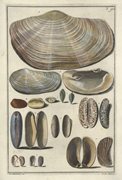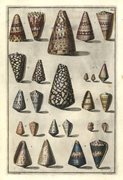A passion for beautiful shells can transform your walls. These homes of small sea creatures have fascinated for centuries. In the 18th century, the large personal shell collection of Italian physician and professor Niccolo Gualtieri, was engraved on copperplates so that the illustrations could be enjoyed by all. Today these superb engravings are rarely seen, but here at Antique Print Club we have a wonderful selection for sale. They are all beautifully hand-coloured, and look stunning when framed. Index Testarum Conchyliorum quae adservantur in Museo Niccolo Gualtieri is the Latin name of this collection.
The Shells in the Museum of Niccolo Gualtieri 
were artistically arranged in their families, with
some shells standing on end and casting small
shadows. The wonderful Italian 18th century
illustrations of these shells combined scientific
observation with an aesthetic appreciation of
their form and colour. They were engraved on
copper by painter, printmaker and Abbot,
Pietro Antonio Pazzi (1706-1766), assisted by
Bernardo Sansone Sgrilli (engraver, 1733-55).
The main draftsman for these engravings was
Giuseppe Menabuoni (1708-45), assisted by Giovanni Domenico Campiglia (1692-1768).
Niccolo Gualtieri (1688-1744) co-founded the first botanical society in Europe, the Botanical Society of Florence, in 1716. It was not uncommon for medical professionals to be interested in botany, as their research produced early cures from herbs and plants. Conchology (the study of shells) was more unusual, and Gualtieri devised a system of classification for his enormous collection of molluscs shells, Molluscs are marine animals without backbones. Each mollusc secretes the shell substance that spreads around it and becomes solid to provide protection for the animal's soft body. Wow! Isn't nature clever?
Around 700 shells from Gualtieri's collection are now in the Museo storia natural di Pisa (Pisa Museum of Natural History), in the municipality of Calci just outside the city of Pisa. Gualtieri Shells, hand-coloured copperplate engravings circa 1742, are spectacular (measuring 45.5 x 32.5cm (37 x 24cm to the 'intaglio impression' plate mark). Some of them are grand pairs of horizontal shells (one above). All engravings are the same size to the plate mark.




Brisbane Antique Emporium in Clayfield, Brisbane has the grand 18th century engravings of Gualtieri shells on display - as well as many others.
Beautiful shell engravings by Edinburgh engraver of nature, William Home Lizars (1788-1859) for Captain Thomas Brown (1785-1862). Smaller antique shell engravings (22.5 x 14cm) are from "A History of the Earth and Animated Nature" by Oliver Goldsmith (1730-1774), who rather ambitiously attempted to bring together a history of the earth with a description of its geographical features and many of its species. It was a popular work (mainly for the wonderful illustrations which were each hand-coloured). First published in England in from 1774, it was reissued in many abridged versions, until 1824, the Goldsmith shell engravings we have found are c1848-52.
Small shell groups in Benard's engravings for Henri-Joseph Redoute, and small individual shells by Richard Polydore Nodder for George Shaw, are around the same size.
Even smaller are the delightful 18th century engravings of collections of American shells by R.P. Labat, and the exquisite groups of tiny shell engravings by the Sowerby family of engravers. Hand-coloured original engravings of a wide range of shells and other marine life are both interesting and decorative when framed.
Conchology (shells) are featured in the Autumn 2016 (Australian) edition of Antiques & Collectables, for Pleasure and Profit (available from your newsagent).